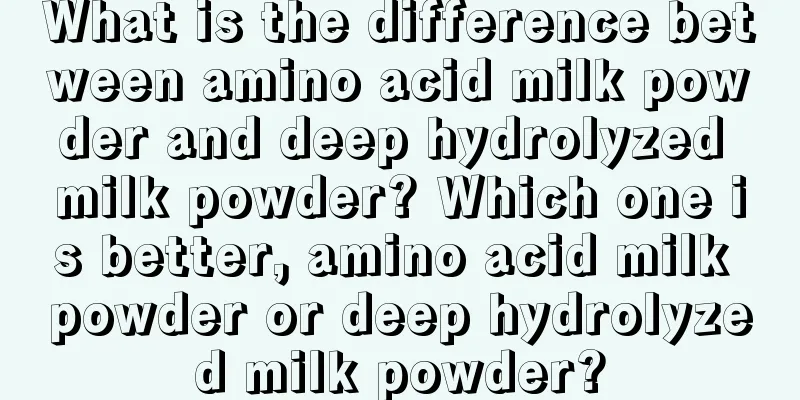What is the difference between amino acid milk powder and deep hydrolyzed milk powder? Which one is better, amino acid milk powder or deep hydrolyzed milk powder?

|
The difference between amino acid milk powder and deep hydrolyzed milk powder. Parents who want to know which one is better, amino acid milk powder or deep hydrolyzed milk powder, must not miss the detailed introduction in the afternoon. If the baby is allergic, parents will be very worried. Let's talk about how to do it. The difference between amino acid milk powder and deep hydrolyzed milk powder1. Amino acid milk powder is also called "allergy-free formula". Allergy-free means that the ingredients contained will not cause any allergies. It is mainly suitable for dietary treatment of milk allergies or multiple food protein allergies. Amino acids are the basic units of protein. After the human body ingests food protein, it must first be broken down into amino acids in the body before it can be absorbed and utilized by the body. 2. Amino acid milk powder is different from hydrolyzed milk powder. Hydrolyzed milk powder is also called "hypoallergenic milk powder". It is made by degrading the protein in milk into peptide chains through a special process to reduce the allergenicity of the protein. The degree of allergenicity depends on the length of the peptide chain. The deeper the degradation, the lower the allergenicity. Therefore, according to the complexity of the process and the length of the peptide chain, the hydrolyzed milk powder on the market is divided into partially hydrolyzed milk powder and deeply hydrolyzed milk powder. Partially hydrolyzed milk powder can only be used for dietary prevention of food allergies; while deeply hydrolyzed milk powder can be used for dietary treatment of some mild to moderate milk allergies. For babies with moderate or severe milk allergies, amino acid milk powder must be consumed. Compared with hydrolyzed milk powder, amino acid milk powder does not contain any allergic substances and has better efficacy. Ranking of allergenicity of various formula milk powders from high to low: Ordinary infant milk powder → Partially hydrolyzed milk powder → Deeply hydrolyzed milk powder → Amino acid milk powder Can babies use amino acid milk powder for a long time? Is the nutrition sufficient for babies? Amino acid milk powder is the same as ordinary infant milk powder, which can provide the calories, carbohydrates, fats, vitamins and minerals needed for the growth and development of babies aged 0 to 12 months, except that all the proteins are replaced by free amino acids. Therefore, amino acid milk powder is sufficient to meet the nutritional needs of the growth and development of babies aged 0 to 1 year old. Only when the baby is healthy can he have sufficient immunity to resist the invasion of pathogens. 3. Some babies have diarrhea, or symptoms such as red spots and small bumps on their bodies after drinking ordinary milk powder. This is actually because the baby is allergic to milk powder. The allergic reaction caused by children eating milk is medically called "milk protein allergy". The cause of milk allergy is that the baby has an allergic reaction to the protein in milk. Using amino acid formula milk powder instead of ordinary milk powder is undoubtedly the best choice, and this is also the biggest difference between amino acid milk powder and ordinary milk powder. The main symptom of children's milk powder allergy is gastrointestinal discomfort, such as abdominal pain, bloating, refusal to drink milk, vomiting, diarrhea, blood in stool, etc. A small number of milk allergies can also cause constipation in infants and children. When the protein in milk is absorbed by the gastrointestinal tract, it is transported to various organs throughout the body through the blood flow, and allergic reactions in different organs will occur, resulting in other symptoms, such as atopic dermatitis or eczema, wheezing, frequent coughing, frequent runny nose, rhinitis, etc. For this kind of child, on the one hand, we recommend checking for allergens, but the detection of allergens and food intolerance requires venous blood drawing. The child is too young and the mother is a little reluctant. Therefore, we will give another suggestion when the child's symptoms are clear, that is, let the mother use deep hydrolyzed protein milk powder or amino acid milk powder for a trial treatment. If the child likes to eat this kind of milk powder and the symptoms are significantly improved (such as no more vomiting, abdominal distension is significantly reduced, blood in the stool disappears, etc.), then we basically determine that the child is allergic to milk protein. Based on this, we will give the mother a good feeding suggestion: start with amino acid formula milk powder, gradually transition to deep hydrolyzed protein milk powder, then gradually transition to moderately hydrolyzed protein milk powder, and then transition to ordinary milk powder. The length of this time should be determined according to relevant factors such as the severity of the child's allergy. 4. The protein in the deeply hydrolyzed milk powder has been decomposed into free amino acids or dipeptides and tripeptides composed of 2-3 amino acids through heat processing or enzymatic decomposition. Some babies who are allergic to cow's milk protein can indeed tolerate deeply hydrolyzed milk powder after continuously feeding amino acid milk powder. Therefore, when switching from amino acid milk powder to deep hydrolyzed milk powder, it is necessary to strengthen observation. When allergic symptoms reappear, it must be stopped in time and continue to feed with amino acid milk powder. In addition, in order to avoid interference from other ingredients in the formula, it is recommended to first consider changing to deep hydrolyzed milk powder of the same brand as amino acid milk powder. Refilling treatment will be more suitable for the baby. For babies who are allergic to cow's milk protein, they should continue to be fed with amino acid milk powder for 6 months, preferably after they are one year old, before considering switching to deep hydrolyzed milk powder. Similarly, when switching to deep hydrolyzed milk powder, the baby may have allergic symptoms again. If this happens, they must switch back to amino acid milk powder. In general, it is recommended that mothers should continue to feed their babies with amino acid milk powder for at least 6 months, and consider switching to deep hydrolyzed milk powder after the baby is one year old. This can help babies with milk allergies to avoid allergies and reduce the risk of recurring allergies. If you switch to deep hydrolyzed milk powder too early, the baby's allergies may recur, resulting in a delayed duration of milk allergies and restricted growth and development. Which is better, amino acid or deep hydrolyzed milk powder?Deeply hydrolyzed milk powder is suitable for babies with more serious allergies. Moderately hydrolyzed milk powder is suitable for babies with less severe allergies. If your baby has an allergic constitution and you are not sure how serious the allergy is, you should usually choose goat milk first to see how it adapts, then choose moderately hydrolyzed milk powder, and finally consider deeply hydrolyzed milk powder. Slowly eliminate them in order. The best way is to take your baby to the hospital for an allergen test and choose according to the severity of the situation. The amino acid formula is a mixed formula of plant amino acids and does not contain any milk ingredients. It is a milk-free formula. It is suitable for the diagnosis of milk allergies and the treatment of severe cases. The deep hydrolysis formula is a short peptide formula after industrial processing of milk protein. It is a milk formula. It is suitable for the treatment of milk allergies, but it has no diagnostic value. After at least 2-4 weeks of use, the amino acid formula can be gradually replaced with a deep hydrolysis formula for 3-6 months, and then replaced with a partially hydrolyzed formula. How to choose amino acid and deep hydrolyzed milk powderThe main difference is: the amino acid formula is a mixed formula of plant amino acids according to the baby's allergy degree, does not contain any milk ingredients, and is a milk-free formula. It is suitable for the diagnosis of milk allergy and the treatment of severe cases. The deep hydrolysis formula is a short peptide formula after industrial processing of milk protein, which is a milk formula. It is suitable for the treatment of milk allergy, but has no diagnostic value. |
>>: Will breastfeeding make your breasts bigger? Changes in breasts after breastfeeding
Recommend
What should I do if my baby has yellow hair? What is the reason for my baby's yellow hair?
The baby's hair is sparse, soft and yellow. M...
How can parents strengthen parent-child bonding during holidays?
In the process of growing up, sufficient interact...
Is frequent urination normal during pregnancy? Why do I urinate frequently during pregnancy?
Everyone must have heard of a lot of pregnancy di...
Which country does the Chinese toothpaste belong to? Where is the Chinese toothpaste produced?
When I heard the name of Zhonghua Toothpaste, I f...
Can children drink Wang Laoji? Can children drink Wang Laoji?
Can children drink Wanglaoji? In summer, the inte...
Can the postpartum illness after giving birth to a second child be cured?
The saying that postpartum diseases can be cured ...
Why is it easy for second children to be born prematurely? Will second children definitely be born prematurely?
Why is it easy for second children to be born pre...
Where can I watch Kim Soo Hyun and Choi Sulli Real? The full version of Kim Soo Hyun and Choi Sulli Real is available
There must be many guys who want to watch the ful...
Can you get pregnant with a small amount of menstrual flow? The key is whether you can ovulate
Infrequent menstruation is a very common disease....
Will massaging the belly of a pregnant woman speed up the fetus' entry into the pelvis?
When a pregnant woman is in the late stage of pre...
How long does it take for lochia to be discharged after a caesarean section? How long does it take for lochia to be discharged after a caesarean section to be considered normal?
Generally, after giving birth, pregnant women wil...
Can pregnant women eat spicy strips? What will happen if pregnant women eat spicy strips?
Spicy noodles are a snack that many young people ...
What services are included in a doula delivery? Does a doula delivery require an episiotomy?
Before giving birth, many mothers heard that the ...
What are the symptoms of a pregnant woman before giving birth?
A recent news report said that a pregnant woman w...
What is the reason for the newborn baby's oily hair? What should I do if the newborn baby has oily hair?
The baby is only 2 weeks old and needs proper nut...









